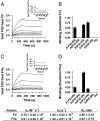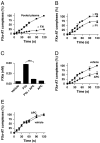Activated factor V is a cofactor for the activation of factor XI by thrombin in plasma
- PMID: 20439754
- PMCID: PMC2889092
- DOI: 10.1073/pnas.1004741107
Activated factor V is a cofactor for the activation of factor XI by thrombin in plasma
Abstract
The mechanism by which the intrinsic pathway of coagulation contributes to physiological hemostasis is enigmatic. Thrombin activates factor XI, a key zymogen in this pathway, which leads to increased thrombin generation. As thrombin-dependent activation of factor XI in vitro is relatively inefficient, we hypothesized that a physiological cofactor supports this reaction in a plasma environment. We therefore investigated whether the cofactors of coagulation, activated factor V, activated factor VIII, high-molecular weight kininogen, or protein S, influenced activation of factor XI by thrombin. Only activated factor V stimulated activation of factor XI by thrombin in a purified system. Binding studies demonstrated that factor XI specifically interacts with both factor V and factor Va through multiple binding sites. We further investigated this cofactor function of activated factor V in plasma. Depletion of factor V, or the addition of activated protein C, decreased the activation of the intrinsic pathway by thrombin in plasma. However, activated protein C did not exert this effect in the plasma of a homozygous carrier of the prothrombotic factor V Leiden mutation. In conclusion, we propose a role for (activated) factor V as a cofactor in the activation of factor XI by thrombin. These findings offer insights into the coagulation system in both health and disease.
Conflict of interest statement
The authors declare no conflict of interest.
Figures




Similar articles
-
Polyphosphate is a cofactor for the activation of factor XI by thrombin.Blood. 2011 Dec 22;118(26):6963-70. doi: 10.1182/blood-2011-07-368811. Epub 2011 Oct 5. Blood. 2011. PMID: 21976677 Free PMC article.
-
Prothrombin is a cofactor for the binding of factor XI to the platelet surface and for platelet-mediated factor XI activation by thrombin.Biochemistry. 1998 Feb 24;37(8):2271-81. doi: 10.1021/bi972113+. Biochemistry. 1998. Retraction in: Biochemistry. 2007 Nov 6;46(44):12886-7. doi: 10.1021/bi701501k. PMID: 9485373 Retracted.
-
Activation of factor XI in plasma is dependent on factor XII.Blood. 1993 Feb 1;81(3):580-6. Blood. 1993. PMID: 8427954
-
The role of factor XI in coagulation: a matter of revision.Semin Thromb Hemost. 1999;25(4):419-28. doi: 10.1055/s-2007-994944. Semin Thromb Hemost. 1999. PMID: 10548074 Review.
-
Roles of platelets and factor XI in the initiation of blood coagulation by thrombin.Thromb Haemost. 2001 Jul;86(1):75-82. Thromb Haemost. 2001. PMID: 11487044 Review.
Cited by
-
Coagulation Factor XI Promotes Distal Platelet Activation and Single Platelet Consumption in the Bloodstream Under Shear Flow.Arterioscler Thromb Vasc Biol. 2016 Mar;36(3):510-7. doi: 10.1161/ATVBAHA.115.307034. Epub 2016 Jan 14. Arterioscler Thromb Vasc Biol. 2016. PMID: 26769048 Free PMC article.
-
Polyphosphate is a cofactor for the activation of factor XI by thrombin.Blood. 2011 Dec 22;118(26):6963-70. doi: 10.1182/blood-2011-07-368811. Epub 2011 Oct 5. Blood. 2011. PMID: 21976677 Free PMC article.
-
New Tools to Study Contact Activation.Front Med (Lausanne). 2016 Nov 22;3:58. doi: 10.3389/fmed.2016.00058. eCollection 2016. Front Med (Lausanne). 2016. PMID: 27921033 Free PMC article.
-
Activation of factor XI by products of prothrombin activation.Blood. 2011 Jul 14;118(2):437-45. doi: 10.1182/blood-2010-10-312983. Epub 2011 Apr 28. Blood. 2011. PMID: 21527525 Free PMC article.
-
Evidence for factor IX-independent roles for factor XIa in blood coagulation.J Thromb Haemost. 2013 Dec;11(12):2118-27. doi: 10.1111/jth.12435. J Thromb Haemost. 2013. PMID: 24152424 Free PMC article.
References
-
- Davie EW, Ratnoff OD. Waterfall sequence for intrinsic blood clotting. Science. 1964;145:1310–1312. - PubMed
-
- MacFarlane RG. An enzyme cascade in the blood clotting mechanism, and its function as a biochemical amplifier. Nature. 1964;202:498–499. - PubMed
-
- Doggen CJ, Rosendaal FR, Meijers JC. Levels of intrinsic coagulation factors and the risk of myocardial infarction among men: Opposite and synergistic effects of factors XI and XII. Blood. 2006;108:4045–4051. - PubMed
MeSH terms
Substances
LinkOut - more resources
Full Text Sources
Research Materials

